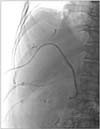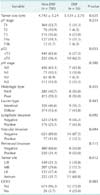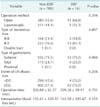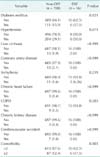Abstract
Purpose
A duodenal stump fistula is one of the most severe complications after gastrectomy for gastric cancer. We aimed to analyze the risk factors for this problem, and to identify the methods used for its prevention and management.
Methods
We retrospectively reviewed the clinical data of 716 consecutive patients who underwent curative gastrectomy with a duodenal stump for gastric cancer between 2008 and 2013.
Results
A duodenal stump fistula occurred in 16 patients (2.2%) and there were 2 deaths in this group. Univariate analysis revealed age >60 years (odds ratio [OR], 3.09; 95% confidence interval [CI], 0.99–9.66), multiple comorbidities (OR, 4.23; 95% CI, 1.50–11.92), clinical T stage (OR, 2.91; 95% CI, 1.045-8.10), and gastric outlet obstruction (OR, 8.64; 95% CI, 2.61–28.61) to be significant factors for developing a duodenal stump fistula. Multivariate analysis identified multiple comorbidities (OR, 3.92; 95% CI, 1.30–11.80) and gastric outlet obstruction (OR, 5.62; 95% CI, 1.45–21.71) as predictors of this complication.
A duodenal stump fistula (DSF) forming after a gastrectomy for gastric cancer is a life-threatening complication. Even though the overall incidence is low (1.8%–3%), the DSF-related mortality rate is reported to be 7% to 67% [123]. There are many DSF-related complications leading to longer hospitalization times, such as intra-abdominal abscesses, wound infections, diffuse peritonitis, sepsis, malnutrition, pancreatitis, abdominal bleeding, and pneumonia [1].
DSF is thought to be caused by many factors such as inadequate closure of the duodenal stump, devascularization, cancer involvement or resection, an inflamed duodenal wall, local hematoma, incorrect drain position and postoperative distension of the duodenum [4]. Orsenigo et al. [5] first reported the risk factors associated with postoperative DSF to be heart disease, liver cirrhosis, intraoperative blood loss (>300 mL) and the absence of manual reinforcement. However, that analysis focused on intraoperative factors. The aim of the present study was to analyze the risk factors for DSF that could be revealed during the preoperative evaluation for obtaining informed consent before surgery. By identifying them, we should be able to pay more attention to patients who are in high-risk groups during the surgery and postoperative management. The risk factors for DSF after gastrectomy for gastric cancer were analyzed retrospectively, and we also describe the methods used for prevention and management of DSF in our institution.
The records of 1,018 consecutive patients who underwent curative gastrectomy from November 2008 to December 2013 were reviewed retrospectively. All of the patients had gastric cancer. Among them, 716 had a duodenal stump after gastrectomy. The methods used for intestinal reconstruction were Billroth II gastrojejunostomy (B-II) with jejunojejunostomy (Braun's anastomosis) or Roux-en Y (R-Y) gastrojejunostomy for subtotal gastrectomy and R-Y esophagojejunostomy for total gastrectomy.
DSF was diagnosed by the presence of duodenal fluid in the surgical drainage and confirmed by a CT scan when needed. The location of any tumor in the stomach was classified into 4 regions: antrum, stomach angle to lower body, mid body to high body, and cardia/fundus [6].
Duodenal transection was performed using a linear stapler (DST Series TA 60 mm, Covidien, Boulder, CO, USA) in cases involving open gastrectomy. In laparoscopic cases, a laparoscopic linear stapler (ECHELON FLEX ENDOPATH, Ethicon Endo-Surgery, Cincinnati, OH, USA) was used for duodenal transection. For surgery involving B-II with Braun's anastomosis, a side-to-side gastrojejunostomy was made approximately 40 cm distal to the ligament of Treitz via the antecolic pathway, and Braun's anastomosis was performed about 25 cm distal to the gastrojejunostomy. In patients who underwent an R-Y anastomosis, the jejunum was brought through the antecolic route after its division. The distance between gastrojejunostomy and the jejunojejunal anastomosis was about 25 cm, which is considered adequate for preventing bile reflux, with respect to intestinal limb length and Roux stasis or kinking.
To prevent DSF during surgery, we used an absorbable reinforcement felt (Neoveil, Gunze Limited, Shenzhen, China) and a fibrin sealant (Tisseel, Baxter AG, Wien, Austria) on the duodenal stump.
All data were analyzed using IBM SPSS Statistics ver. 21.0 (IBM Co., Armonk, NY, USA). Categorical outcomes were analyzed using the chi-square test and Fisher exact test. Mean differences between the two groups (with and without DSF) were analyzed using Student t-test. Independent risk factors associated with DSF after gastrectomy were analyzed using logistic regression analysis. The odds ratios (ORs) were estimated with 95% confidence intervals (CIs). Differences were considered statistically significant at P < 0.05.
A DSF after gastrectomy for gastric cancer was found in 16 of the 716 patients (2.2%). The demographic characteristics of patients with and without DSF are summarized in Table 1. The 2 groups were similar with regard to age, sex, and body mass index. However, there was a statistically significant difference in the American Society of Anesthesiologists (ASA) physical status score between the 2 groups (P = 0.026).
Table 2 shows the oncological characteristics of patients with and without DSF. The complication occurred more frequently in patients with tumors graded more than pT2 (P = 0.033). There was a significant difference in the incidence of DSF in patients with tumors located at the antrum compared with those with tumors located at the stomach angle to low body (P = 0.012). Patients who had a gastric outlet obstruction (GOO) before gastrectomy also had a higher occurrence rate (P = 0.003).
The surgical characteristics of patients in the 2 groups are shown in Table 3. The surgical method, type of reconstruction, type of gastrectomy, extent of lymph node dissection, operation time, and intraoperative blood loss were compared. However, there were no statistically significant differences between the 2 groups.
Univariate analysis was used to evaluate comorbidity factors in the 2 groups. The comorbidity factors used in our study were diabetes mellitus (DM), hypertension, liver cirrhosis, coronary artery disease, arrhythmia, chronic heart failure, chronic obstructive pulmonary disease, chronic kidney disease, and cerebrovascular accident. Patients under medication or observation after diagnosis with these comorbidities were all included in our analysis. Only DM showed a statistically significant difference between the two groups (P = 0.021). In addition, patients with multiple comorbidities had a significantly higher rate of DSF (P = 0.003). The results are summarized in Table 4.
Univariate analysis showed that age, ASA score, pathology T stage, tumor location, GOO, DM, and multiple comorbidities were significant factors for developing a DSF. In the multivariate analysis, multiple comorbidities (OR, 3.92; 95% CI, 1.30–11.80) and GOO (OR, 5.62; 95% CI, 1.45–21.71) were the risk factors for DSF (Table 5). Tumor location was excluded from this analysis because GOO only occurred in tumors located at the antrum.
The clinicopathology results of patients who developed DSF are shown in Table 6. DSF occurred in 16 patients (2.2%) and there were 2 deaths in this subgroup. The mean interval of DSF after operation was 6.6 days. Both of the deaths were associated with complications from DSF [1]. One patient died from sepsis and bleeding and the other patient died from pneumonia. Three patients were submitted to a reoperation at postoperative days 1 or 2. Primary repair of the duodenal stump with choledochostomy and feeding jejunostomy was performed for these patients. Six patients were managed by ultrasound-guided PTBD. Seven other patients recovered with supportive care such as percutaneous drainage, TPN, and octreotide treatment. The mean duration of hospital stay after surgery was 29.4 days.
DSF after gastrectomy for gastric cancer is a rare complication with an incidence of 1.8%–3% [123]. However, once DSF occurs it is a life-threatening complication with a mortality rate of 7%–67% [123]. In our study, the incidence of DSF was 2.2% and the mortality rate was 12.5% in those patients. One patient died from sepsis and bleeding and the other patient died from pneumonia following DSF. These are common complications from DSF [1].
Various factors have been reported to cause DSF [4]. Orsenigo et al. [5] first reported the risk factors associated with postoperative DSF to be heart disease, liver cirrhosis, intraoperative blood loss (>300 mL), and the absence of manual reinforcement. We found here that age, ASA score, pathology T stage, tumor location, GOO, DM, and multiple comorbidities were significant factors for DSF in the univariate analysis. Multivariate analysis showed that GOO (OR, 5.62; 95% CI, 1.45–21.71) and multiple comorbidities (OR, 3.92; 95% CI, 1.30–11.80) were the main risk factors for DSF after gastrectomy for gastric cancer. GOO occurs more frequently when gastric cancer locates in lower body, i.e., antrum. GOO can also cause inflammation at surrounding duodenal wall tissues. For these reasons, we secure more distal margin because of the danger that cancer can involve at resection line, and eventually more devascularization is required. This is why we think GOO could be a risk factor of DSF shown in our study [47].
GOO and multiple comorbidities are both easily revealed during preoperative evaluation for DSF (Fig. 1). Patients can be categorized into high-, and low-risk groups. High-risk patients are those who have GOO or multiple comorbidities. Low-risk patients are those who have no symptoms of obstruction and no more than a single comorbidity. This means that we can anticipate the risk before the operation and prepare to make an appropriate decision when DSF is doubtful. Moreover, the surgeon can pay more attention during the operation to prevent DSF from occurring.
To prevent DSF during surgery, we used an absorbable reinforcement felt (Neoveil, Gunze Limited, Shenzhen, China) [8910] and a fibrin sealant (Tisseel, Baxter AG, Wien, Austria) [1112] on the duodenal stump. First, we applied the fibrin sealant onto the duodenal stump and then sealed it with the absorbable reinforcement felt. The fibrin sealant was then reapplied to prevent DSF (Fig. 2).
Many methods have been proposed for the treatment of DSF such as surgical management, a percutaneous approach, enteral and/or TPN, and therapy with somatostatin and its analogues. The usual surgical treatments are tube duodenostomy [13], repair with a rectus abdominis muscle flap [14], closure by Rouxen-Y duodenojejunostomy [15], and pancreaticoduodenectomy [16]. The usual methods of a percutaneous approach are abscess drainage, transhepatic biliary drainage [1718], fistula closure using cyanoacrylate or prolamine [19], percutaneous transhepatic biliary drainage (PTBD), occlusion balloons [20] or Foley balloon catheter [21].
Three patients in our study underwent a reoperation involving primary repair of the duodenal stump using choledochostomy and feeding jejunostomy. Ultrasound-guided PTBD was performed for six of them (Fig. 3). The other seven patients recovered with supportive care. The mean duration of hospital stay after surgery was 29.4 days.
In conclusion, DSF is a life-threatening problem after gastrectomy for gastric cancer. Comorbidity and GOO were independent risk factors for DSF in our multivariate analysis. We generated a flow chart for risk factors based on these results. Surgeons could use this and pay more attention to prevent DSF in high-risk groups, and manage them more aggressively when DSF is anticipated.
Figures and Tables
Fig. 1
Flow chart of identified risk factors for duodenal stump fistula after gastrectomy. GOO, gastric outlet obstruction.

Fig. 2
Methods used to prevent duodenal stump fistula in our institution. (A) Fibrin sealant being applied to the duodenal stump. (B) Absorbable reinforcement felt used to seal over the duodenal stump.

Fig. 3
Ultrasound-guided percutaneous transhepatic biliary drainage (PTBD) was used to divert bile from the duodenal stump. Right PTBD was done via B6 (segmental bile duct from segment 6 of liver) with an 8.5-F pigtail catheter.

References
1. Rossi JA, Sollenberger LL, Rege RV, Glenn J, Joehl RJ. External duodenal fistula: causes, complications, and treatment. Arch Surg. 1986; 121:908–912.
2. Tarazi R, Coutsoftides T, Steiger E, Fazio VW. Gastric and duodenal cutaneous fistulas. World J Surg. 1983; 7:463–473.
3. Edmunds H Jr, Williams GM, Welch CE. External fistulas arising from the gastrointestinal tract. And prospective overview. 1960. Nutrition. 2003; 19:182–186.
4. Cozzaglio L, Coladonato M, Biffi R, Coniglio A, Corso V, Dionigi P, et al. Duodenal fistula after elective gastrectomy for malignant disease : an italian retrospective multicenter study. J Gastrointest Surg. 2010; 14:805–811.
5. Orsenigo E, Bissolati M, Socci C, Chiari D, Muffatti F, Nifosi J, et al. Duodenal stump fistula after gastric surgery for malignancies: a retrospective analysis of risk factors in a single centre experience. Gastric Cancer. 2014; 17:733–744.
6. Park HS, Lee SY, Hong SN, Kim JH, Sung IK, Park HS, et al. Early gastric cancer-like advanced gastric cancer versus advanced gastric cancer-like early gastric cancer. Clin Endosc. 2013; 46:155–160.
7. Jay BS, Burrell M. Iatrogenic problems following gastric surgery. Gastrointest Radiol. 1977; 2:239–257.
8. Saito T, Kaneda H, Konobu T, Saito Y. The covering with forceps-assisted polymeric biodegradable sheet and endostapling method: a simplified technique for wide coverage and reinforcement of staple-line in video-assisted thoracoscopic bullectomy for spontaneous pneumothorax. Interact Cardiovasc Thorac Surg. 2011; 12:103–105.
9. Kuwata T, Shinohara S, Takenaka M, Oka S, Chikaishi Y, Hirai A, et al. The impact of covering the bulla with an absorbable polyglycolic acid (PGA) sheet during pneumothorax surgery. Gen Thorac Cardiovasc Surg. 2015; Apr. 10. [Epub]. DOI: 10.1007/s11748-015-0545-8.
10. Hayashibe A, Sakamoto K, Shinbo M, Makimoto S, Nakamoto T. New method for prevention of bile leakage after hepatic resection. J Surg Oncol. 2006; 94:57–60.
11. Wang X, Ren J, Zhu W, Li N, Li J. Fibrin sealant prevents gastrointestinal anastomosis dehiscence in intra-abdominal sepsis. Int Surg. 2007; 92:27–31.
12. Kotzampassi K, Eleftheriadis E. Tissue sealants in endoscopic applications for anastomotic leakage during a 25-year period. Surgery. 2015; 157:79–86.
13. Levy E, Cugnenc PH, Frileux P, Hannoun L, Parc R, Huguet C, et al. Postoperative peritonitis due to gastric and duodenal fistulas: operative management by continuous intraluminal infusion and aspiration: report of 23 cases. Br J Surg. 1984; 71:543–546.
14. Chander J, Lal P, Ramteke VK. Rectus abdominis muscle flap for high-output duodenal fistula: novel technique. World J Surg. 2004; 28:179–182.
15. Ujiki GT, Shields TW. Roux-en-Y operation in the management of postoperative fistula. Arch Surg. 1981; 116:614–617.
16. Musicant ME, Thompson JC. The emergency management of lateral duodenal fistula by pancreaticoduodenectomy. Surg Gynecol Obstet. 1969; 128:108–114.
17. Villar R, Fernandez R, Gonzalez J, Oliver JM, Parga G, Garcia-Hidalgo E. High-output external duodenal fistula: treatment with percutaneous transhepatic biliary/duodenal drainage. Cardiovasc Intervent Radiol. 1996; 19:371–373.
18. Zarzour JG, Christein JD, Drelichman ER, Oser RF, Hawn MT. Percutaneous transhepatic duodenal diversion for the management of duodenal fistulae. J Gastrointest Surg. 2008; 12:1103–1109.
19. Bianchi A, Solduga C, Ubach M. Percutaneous obliteration of a chronic duodenal fistula. Br J Surg. 1988; 75:572.
20. Cozzaglio L, Cimino M, Mauri G, Ardito A, Pedicini V, Poretti D, et al. Percutaneous transhepatic biliary drainage and occlusion balloon in the management of duodenal stump fistula. J Gastrointest Surg. 2011; 15:1977–1981.
21. Korean Gastric Cancer Association. Gastric cancer and gastrointestinal diseases. Seoul: Ilchokak;2011.




 PDF
PDF ePub
ePub Citation
Citation Print
Print








 XML Download
XML Download